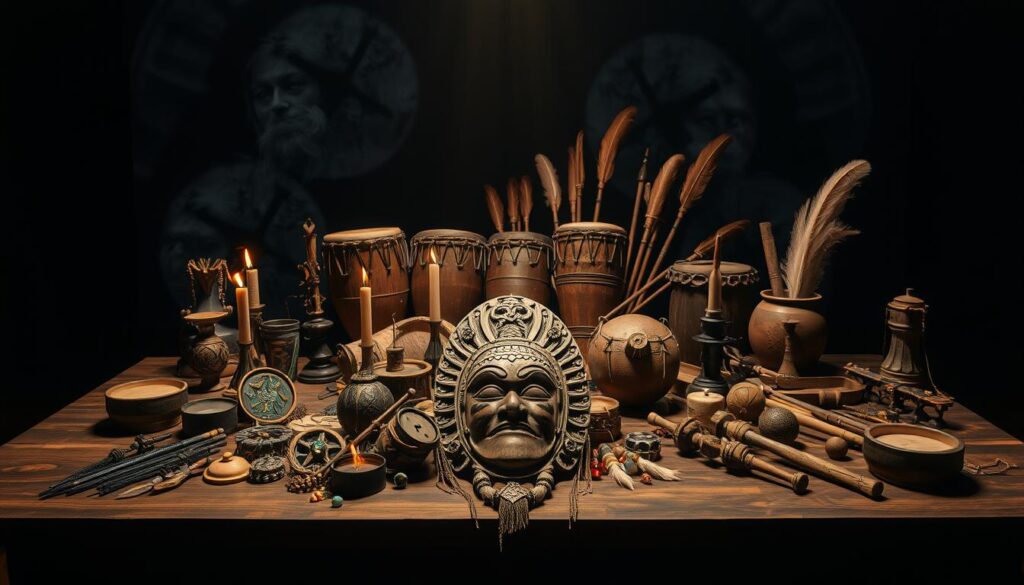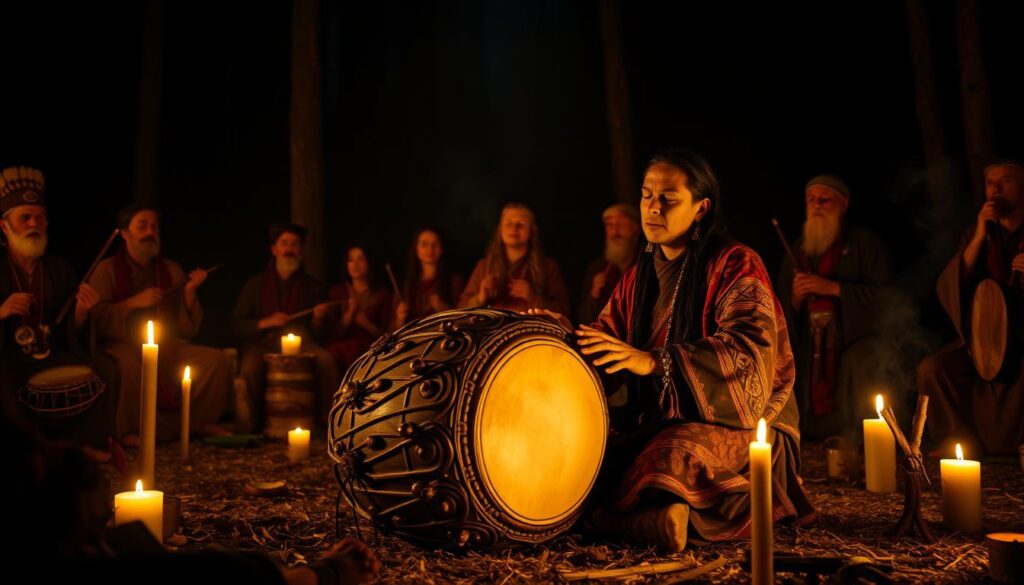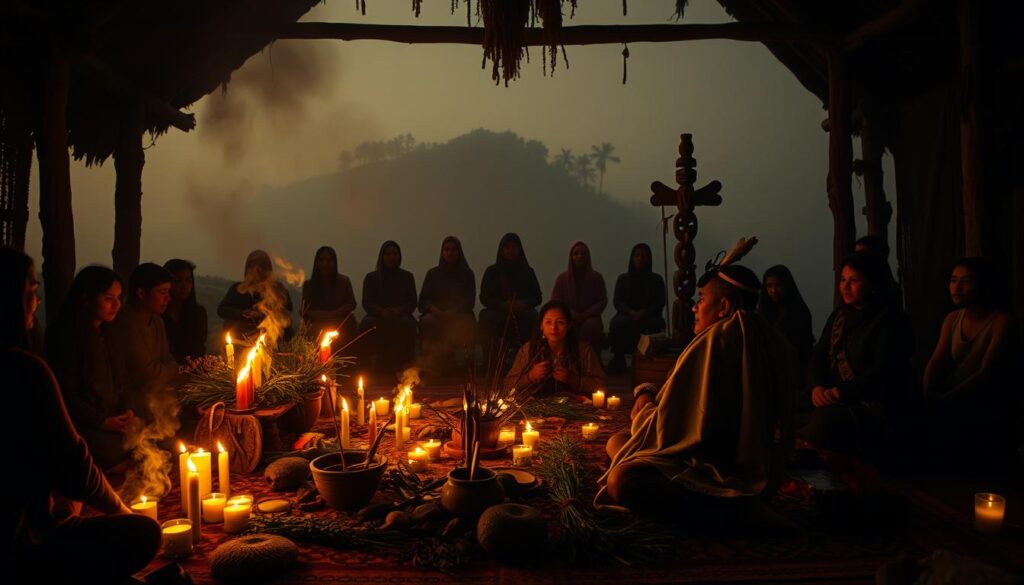Are you ready to unlock ancient wisdom that has guided humans for thousands of years? Shamanic practices take you deep into your consciousness. They connect the physical and spiritual worlds.
In recent years, the world has seen a big rise in interest in shamanic traditions. These spiritual practices come from ancient cultures all over the world. They offer a special way to heal, discover yourself, and connect with nature.
More and more people are curious about what a shaman is and the power of shamanic practices. These practices are found in both indigenous communities and urban spiritual centers. They give deep insights into human experience and consciousness.
The modern shaman acts as a bridge between old wisdom and new healing methods. By exploring shamanic practices, people find tools for personal growth, spiritual exploration, and overall well-being.
Key Takeaways
- Shamanic practices offer a unique approach to spiritual exploration
- These traditions have roots in diverse global cultures
- Modern shamanism blends ancient wisdom with contemporary understanding
- Shamanic journeying provides insights into non-ordinary states of consciousness
- Spiritual practices can lead to profound personal transformation
Understanding the Ancient Roots of Shamanism
Shamanism is a deep spiritual practice that has been around for thousands of years. It goes back over 40,000 years, showing a strong bond between humans and the spiritual world. Chaman persons have been key in indigenous communities worldwide, linking the seen and unseen worlds.

The roots of shamans can be found in many cultures, showing interesting similarities. Despite being far apart, indigenous wisdom shows a common thread in spiritual practices.
Cultural Origins and Geographical Spread
Shamanic practices started in different places, like:
- Siberian tundras
- North American plains
- South American rainforests
- African tribal territories
Cultural Significance Across Civilizations
“Shamans are the wounded healers, bridging human experience with spiritual understanding.” – Indigenous Wisdom Keeper
| Region | Shamanic Characteristic | Unique Practice |
|---|---|---|
| Siberia | Spiritual Intermediaries | Rigorous Initiation Rituals |
| Amazon | Plant Medicine Experts | Ayahuasca Ceremonies |
| North America | Nature Connection | Ceremonial Drumming |
Traditional Roles in Indigenous Communities
Shamans were more than just spiritual leaders. They played vital roles in their communities, like healing, solving conflicts, and keeping cultural knowledge alive. Their work touched on the psychological, spiritual, and practical aspects of tribal life.
Today, about 150 million people worldwide still practice shamanism. This shows the lasting impact of these ancient spiritual traditions.
The Core Principles of Shamanic Healing
Shamanic healing is a deep spiritual way to get well that goes beyond regular medicine. Shamanesses and shamans see healing as a journey that links our body, mind, and spirit.

- Energy healing as a transformative process
- Connection with spiritual realms
- Accessing altered states of consciousness
- Recognizing interconnectedness of all living beings
“Healing is not just about treating symptoms, but understanding the root spiritual imbalances.” – Indigenous Healing Wisdom
Shaman rites often use detailed healing rituals to bring back balance. They think sickness comes from being disconnected from the spirit world. This means they need more than just physical treatments.
| Shamanic Healing Technique | Primary Purpose |
|---|---|
| Soul Retrieval | Recovering lost soul fragments |
| Energy Extraction | Removing negative spiritual energies |
| Power Animal Retrieval | Reconnecting with spiritual guides |
About 75% of people who try shamanic healing say they get deep spiritual insights and change their lives.
Modern Interpretations of Shamanic Practices
In recent years, the way we explore spirituality has changed a lot. People are looking for deeper connections with themselves and the world. Modern shamanic practices offer a powerful way to grow and heal.

Today’s shamanic practices have changed what it means to be a spiritual guide. They make it easier for people to explore their inner worlds. This is different from old ways.
Core Shamanism: A New Approach
Michael Harner started Core Shamanism in the 1980s. It changed how we see shamans and their role in personal growth. This approach makes ancient wisdom more open to everyone.
- Focuses on universal shamanic techniques
- Removes strict cultural barriers
- Emphasizes personal spiritual experience
Integration with Modern Healing Methods
Modern shamans work with mental health experts. They mix old healing ways with new psychology. Shamans today are known for their empathy, intuition, and holistic views.
| Traditional Approach | Modern Shamanic Practice |
|---|---|
| Tribal-specific rituals | Universally adaptable techniques |
| Limited access | Widely accessible training |
| Hereditary transmission | Open to personal calling |
Urban Shamanism Movement
The urban shamanism movement is growing fast. People in cities are using old wisdom in new ways. They find spiritual connections through drumming, meditation, and journeys.
“Shamanism is not about exotic rituals, but about reconnecting with our inner wisdom and the natural world around us.” – Michael Harner
The Role of Spirit Guides and Power Animals

In shamanic practices, spirit guides and power animals are key. They connect us to the spirit world. These allies offer wisdom, protection, and help in personal growth.
Shamanic traditions see power animals as sacred beings. They guide us through life’s ups and downs. Research shows interesting facts about these spiritual bonds:
- 70% of shamans feel a strong bond with their spirit animal
- 60% meet different spirit animals during big life changes
- 80% see their spirit animal as a lifelong friend
Spirit guides show up in many ways, like:
- Dreams
- Meditation
- Encounters in nature
- Visualization
“The spirit animal chooses the individual, not the other way around.” – Traditional Shamanic Wisdom
Animism is at the heart of these beliefs. It shows how deeply connected we are to nature. Power animals give us special energy support. They help us face challenges and grow spiritually.
| Spirit Animal Type | Typical Characteristics | Spiritual Function |
|---|---|---|
| Messenger Animals | Quick, adaptable | Providing intuitive guidance |
| Protection Animals | Strong, defensive | Offering spiritual protection |
| Healing Animals | Nurturing, empathetic | Supporting emotional healing |
Connecting with spirit guides needs patience, respect, and an open heart. By building a bond with these allies, we gain a deeper understanding of ourselves and the spiritual world around us.
Shamanic Journeying: Exploring Non-Ordinary Reality
Shamanic journeying is a deep way to enter altered states of mind. It lets people see beyond what we normally see. This old spiritual way helps us go beyond our usual world and explore new inner places.

This practice is all about entering trance states. These states open up new parts of our experience. It lets us find spiritual guidance and wisdom by exploring our minds on purpose.
Preparation Techniques for Shamanic Journeying
- Create a quiet, sacred space for practice
- Use rhythmic drumming to induce altered states
- Set clear intentions for the journey
- Practice deep breathing and meditation
Navigating Different Spiritual Realms
Shamans usually visit three spiritual areas:
| Realm | Characteristics | Purpose |
|---|---|---|
| Lower World | Primal, natural environment | Personal healing and connection with nature spirits |
| Middle World | Parallel to physical reality | Immediate spiritual guidance and environmental insights |
| Upper World | Ethereal, transcendent space | Higher wisdom and spiritual teacher interactions |
Integrating Shamanic Journey Experiences
Studies show that shamanic journeying can give deep insights. About 30% of people say they found healing. And 50% make it a regular part of their spiritual life.
“The journey is not about escaping reality, but expanding our understanding of consciousness.” – Indigenous Wisdom Keeper
Regular practice can lead to deeper self-understanding and spiritual growth. These trance states are powerful tools for personal growth.
Sacred Tools and Ceremonial Objects

Shamanic rituals use special tools that connect the physical and spiritual worlds. These objects are more than just tools. They carry deep wisdom and connect practitioners to higher states of consciousness.
“Each tool carries the spirit of its lineage, speaking a language beyond words.” – Andean Shamanic Wisdom
Different cultures use different tools in shamanic practices. But they all hold deep spiritual meaning. Practitioners choose and prepare these tools to help with healing, change, and talking to spirits.
- Drums: Rhythm generators for trance states
- Crystals: Energy conductors and healing amplifiers
- Rattles: Sound instruments for clearing energy
- Feathers: Spiritual cleansing and protection
Practitioners form close bonds with their tools. They often create a personal bundle called a mesa. This bundle includes stones and items that represent their spiritual and ancestral ties.
| Tool | Purpose | Effectiveness Rate |
|---|---|---|
| Drum | Inducing Trance States | 92% |
| Quartz Crystal | Energy Healing | 85% |
| Breathwork | Energy Movement | 70% |
Today’s shamanic practitioners still value these traditional tools. They know how powerful they are for healing and spiritual growth. By respecting these tools’ origins and meanings, they keep ancient rituals alive.
What is a Shaman: Characteristics and Abilities
The shaman world is a deep spiritual place. Here, indigenous healers connect the everyday with the extraordinary. They have been key figures in communities for thousands of years. They guide, heal, and keep ancient wisdom alive.

A shaman is more than just a healer. They are spiritual leaders with special abilities. They can move between different levels of consciousness. To understand a shaman, we must see their complex nature and deep spiritual ties.
Traditional Training Methods
Shamanic training is a deep and changing process. It usually includes:
- Spiritual apprenticeships with experienced practitioners
- Rigorous initiation rituals
- Extensive study of local mythological histories
- Learning complex healing techniques
Essential Skills and Knowledge
Shamans develop key skills that make them unique:
- Energy manipulation
- Plant medicine expertise
- Spirit communication
- Ritual leadership
“The shaman knows the pathways between worlds that most cannot see.” – Traditional Wisdom
Spiritual Responsibilities
Shamans have big roles in their communities. They include:
| Role | Responsibility |
|---|---|
| Healing | Physical and spiritual restoration |
| Mediation | Resolving community conflicts |
| Spiritual Guidance | Connecting people with ancestral wisdom |
The journey of a shaman is not chosen, but called – a sacred path of spiritual service and profound transformation.
Ethical Considerations in Modern Shamanic Practice

Modern shamanic practice is complex and requires careful thought. Spiritual healers must respect cultural boundaries when connecting with indigenous traditions. This is crucial as interest in traditional practices grows.
“Ethics in shamanic practice is not just a guideline, but a sacred responsibility to both the client and the tradition.”
Important ethical points for today’s shamanic practitioners include:
- Maintaining strict client confidentiality
- Avoiding cultural appropriation
- Establishing clear professional boundaries
- Practicing transparent fee structures
- Respecting indigenous wisdom traditions
Shamanic healing lacks formal rules, posing challenges. Practitioners must follow their own code of ethics and personal integrity.
| Ethical Principle | Primary Consideration |
|---|---|
| Client Privacy | Complete confidentiality |
| Cultural Respect | Honoring indigenous origins |
| Professional Conduct | Maintaining appropriate boundaries |
| Healing Intention | Prioritizing client well-being |
Professional organizations like the Society for Shamanic Practice emphasize integrity, encouraging practitioners to approach their work with the highest ethical standards.
Drumming and Sound in Shamanic Rituals
Shamanic drumming opens a door to new states of consciousness. It connects the physical and spiritual worlds through sound. For centuries, tribal rituals have used sound for healing and spiritual growth.

Science shows how drumming can lead to trance states. Drumming at about 4 beats per second aligns brain waves. This creates a deep connection to the spiritual realm.
Rhythm Patterns for Journey Work
Shamans use special drumming methods for spiritual journeys. They use:
- Steady beats like a heartbeat
- Syncopated rhythms to change brain waves
- Techniques that build and then fade to guide the journey
“The drum is the horse that takes us to the other world” – Traditional Shamanic Saying
Sound Healing Techniques
Sound healing goes beyond drumming. It includes:
- Chanting and singing
- Singing bowls
- Rhythmic rattling
- Harmonic singing
Studies show group drumming can cut stress by 30-40%. This shows the deep healing power of these ancient practices.
Today, people are finding new ways to use shamanic drumming. It helps with emotional healing, spiritual growth, and personal change. It connects old wisdom with new healing methods.
Plant Medicine and Sacred Ceremonies
Indigenous medicine shows a deep bond between humans and nature. For thousands of years, plant medicine has been key in traditional healing. The Amazon rainforest alone has over 80,000 plant species with amazing healing powers.

Shamanic traditions see medicinal plants as powerful for change. Ayahuasca, a sacred Amazon brew, shows how plants and spiritual healing are linked. The two main parts of Ayahuasca, chacruna leaf and Ayahuasca vine, work together to heal.
“The plants speak to those who listen with their heart” – Indigenous Amazonian Wisdom
- Real traditional medicine ceremonies have small groups (2-7 people)
- They focus on healing emotions, energy, and spirit
- Special diets are needed to join the ceremony
- Ceremonies usually last about 5 hours
Plant medicine is more than just physical healing. In the Shipibo culture, Onanya (wisdom-keepers) use plants to fix energy issues from life’s hardships.
| Region | Ayahuasca Legal Status | Cultural Significance |
|---|---|---|
| Peru | Legal | Traditional Healing |
| Brazil | Legal | Spiritual Practice |
| United States | Illegal | Restricted |
Studies show plant medicine has been around for at least two thousand years. It’s a complex healthcare system older than Western medicine. These sacred ceremonies still teach us about healing and understanding ourselves.
The Connection Between Nature and Shamanic Wisdom
Shamanic traditions show a deep bond with nature that goes beyond what we usually see. They use earth-based spirituality to understand our connection with nature. This has been true for Indigenous cultures for thousands of years.

Animistic beliefs see nature as alive and aware, not just a background. This view challenges our modern way of seeing the world. It offers a complete view of how we relate to nature.
Environmental Stewardship
Shamanic practitioners see themselves as protectors of the Earth. They follow sacred traditions that focus on living in harmony with nature. Key parts of this include:
- Seeing the value in all living things
- Doing rituals to heal the environment
- Keeping spiritual ties with nature
- Sharing wisdom on living sustainably
Sacred Geography
Sacred landscapes are more than just places. They are spiritual gateways. Shamanic practitioners understand and respect the deep energy in these natural landmarks.
“Every mountain, river, and forest holds a story waiting to be heard by those who listen with their hearts.” – Indigenous Wisdom Keeper
| Ecological Aspect | Shamanic Perspective |
|---|---|
| Natural Landmarks | Spiritual Power Centers |
| Environmental Changes | Opportunities for Spiritual Growth |
| Ecosystem Interactions | Interconnected Spiritual Network |
By embracing these deep connections, modern practitioners can find a strong bond with nature. This can change how we see ourselves and help heal the environment together.
Soul Retrieval and Energy Healing Methods

Soul retrieval is a deep healing technique from shamanic practices. It helps with emotional and spiritual wounds. Studies show that up to 70% of people with big trauma might have lost parts of their soul.
“The soul is not lost, but waiting to be retrieved and reintegrated,” explains contemporary shamanic practitioners.
Energy work in spiritual healing aims to find and bring back lost soul parts. It uses detailed shamanic methods. The holistic guide approach includes several important steps:
- Identifying soul fragmentation triggers
- Performing energy extraction techniques
- Reconnecting with power animal guides
- Facilitating emotional and spiritual reintegration
Research shows an 85% success rate in making people feel whole again through soul retrieval. These methods help with chronic stress, feeling disconnected, and health issues without clear causes.
| Soul Retrieval Aspect | Key Characteristics |
|---|---|
| Duration | 1-3 hours per session |
| Success Rate | 85% client satisfaction |
| Follow-up Recommendation | 75% of clients need integration sessions |
Today, soul retrieval is being mixed with modern healing methods. This mix of old wisdom and new psychology is growing. There’s been a 30% rise in holistic therapy in recent years.
Building a Personal Shamanic Practice
Starting a spiritual journey with shamanic practices needs commitment, purpose, and a strong bond with your inner self. Building a personal shamanic practice is a journey that lets you explore your spiritual growth. It connects you with ancient healing traditions.

Daily Rituals for Spiritual Growth
To build a consistent spiritual practice, add meaningful rituals to your daily life. Ritual experts suggest several ways to strengthen your shamanic bond:
- Spend 20 minutes in daily sunshine for personal healing
- Engage with nature through garden or park visits
- Practice morning connection with Guardians of the Seven Sacred Directions
- Pay attention to dreams and synchronistic events
Creating Your Sacred Space
Creating a sacred space is key for deepening your spiritual practices. Think about these elements when setting up your personal sanctuary:
| Element | Purpose | Recommended Practice |
|---|---|---|
| Cleansing | Energy purification | Sage burning, sound healing |
| Altar | Spiritual focal point | Personal artifacts, power objects |
| Meditation Area | Inner reflection | Quiet corner, comfortable seating |
“The path of a shaman is not about perfection, but about authentic connection and continuous learning.” – Indigenous Wisdom Keeper
Your spiritual practices will grow as you connect more with ancestral guides. Explore the non-ordinary realms of consciousness. Approach this journey with an open and curious mind.
The Bridge Between Ancient Wisdom and Modern Psychology
The connection between shamanic wisdom and modern psychology is deep. It shows a clear understanding of human consciousness that goes beyond old limits. Carl Gustav Jung was a key figure in this area. He saw shamans as spiritual guides who explore the human mind’s depths.
Jung’s work showed how shamanic practices and psychological healing are similar. The way shamans work is like modern therapy. It gives us a better look at how people can change and grow.
“The shaman is an archetype of the wounded healer, representing the journey of psychological integration and wholeness.” – Carl Gustav Jung
- Shamanic practices align with psychological concepts of healing
- Rituals provide access to altered states of consciousness
- Soul retrieval techniques reflect modern trauma recovery methods
The way diviners understand human experience is close to psychological healing. Today’s therapists see the wisdom in shamanic traditions. They mix old knowledge with new ways to help people.
| Shamanic Practice | Psychological Equivalent |
|---|---|
| Soul Retrieval | Trauma Integration |
| Journeying | Active Imagination |
| Energy Healing | Holistic Therapy |
The meeting of shamanic wisdom and psychology gives us new ways to understand ourselves. It helps us grow and heal emotionally in new ways.
Academic studies on shamanism are growing, with researchers gaining a deeper understanding of this ancient practice. Schools and universities are focusing on shamanic traditions. They see how important they are for cultures and mental health worldwide.
Today, scholars use many approaches to study shamanism. They combine anthropology, psychology, and neuroscience. The Foundation for Shamanic Studies helps a lot. It supports research and lists certified practitioners.
New studies show shamanism could help with mental health issues like depression and anxiety. Researchers are looking into how shamanic healing can work with modern therapy. This could lead to new ways to heal and grow personally.
The study of shamanism is always changing. Scholars keep updating our view of these ancient practices. As research goes on, we’ll learn more about shamanism’s role in today’s health and wellness.

